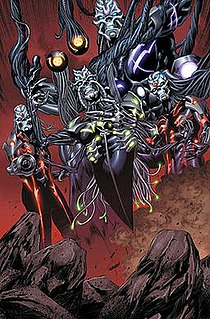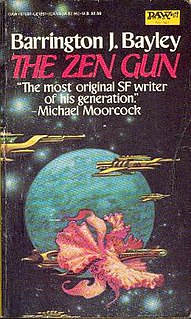
Jedi, Jedi Knights, or collectively the Jedi Order are the main heroic protagonists of many works of the Star Wars franchise. Working symbiotically alongside the Old Galactic Republic, and later supporting the Rebel Alliance, the Jedi Order is depicted as a monastic, academic, military, and meritocratic peacekeeping organization whose origin dates back thousands of years before the events of the first film released in the franchise. The fictional organization has inspired a real-world new religious movement and parody religion: Jediism.

The Galactic Empire is a fictional autocracy featured in the Star Wars franchise. It was first introduced in the 1977 film Star Wars and appears in its two sequels: The Empire Strikes Back (1980) and Return of the Jedi (1983). It is the main antagonistic faction of the original trilogy. An oppressive, autocratic regime with a complicated bureaucracy, the Galactic Empire seeks to ensure singular rule and social control over every planet and civilization within the galaxy.

Babel-17 is a 1966 science fiction novel by American writer Samuel R. Delany in which the Sapir–Whorf hypothesis plays an important part. It was joint winner of the Nebula Award for Best Novel in 1967 and was also nominated for the Hugo Award for Best Novel in 1967.

The Alliance to Restore the Republic is a fictional stateless interstellar coalition of republican dissidents, revolutionary factions and anti-imperialist clandestine cell systems in a resistance movement against the imperialist Galactic Empire. The Alliance's goal is to restore the Galactic Republic. It is the main protagonist faction of the original Star Wars trilogy, parallel to the mostly fallen Jedi Order survived by Obi-Wan Kenobi, Yoda, and later Luke Skywalker.

The Galactic Republic, often referred to as simply the Republic, is a fictional galactic polity depicted in the Star Wars universe, where it existed prior to the establishment of the Galactic Empire. The Republic is most prominently portrayed in the prequel trilogy of films in the Star Wars franchise. In the original trilogy, set later in time, it is referred to as the Old Republic.

Hoth is an ice planet in the Star Wars fictional universe. It first appeared in the 1980 film The Empire Strikes Back and has also been a setting in Star Wars books and video games.

Foundation is a science fiction novel by American writer Isaac Asimov. It is the first published in his Foundation Trilogy. Foundation is a cycle of five interrelated short stories, first published as a single book by Gnome Press in 1951. Collectively they tell the early story of the Foundation, an institute founded by psychohistorian Hari Seldon to preserve the best of galactic civilization after the collapse of the Galactic Empire.

Legend of the Galactic Heroes, sometimes abbreviated as LOTGH, LOGH or Gin'eiden (銀英伝) in Japanese, is a series of science fiction novels written by Yoshiki Tanaka. In humanity's distant future, two interstellar states – the monarchic Galactic Empire and the democratic Free Planets Alliance – are embroiled in a never-ending war. The story focuses on the exploits of rivals Reinhard von Lohengramm and Yang Wen-li, as they rise to power and fame in the Galactic Empire and the Free Planets Alliance, respectively.

The Wow! signal was a strong narrowband radio signal detected on August 15, 1977, by Ohio State University's Big Ear radio telescope in the United States, then used to support the search for extraterrestrial intelligence. The signal appeared to come from the direction of the constellation Sagittarius and bore the expected hallmarks of extraterrestrial origin.

The Phalanx are a fictional cybernetic species appearing in American comic books published by Marvel Comics. They have come in conflict with the X-Men as well as other groups on several occasions. They form a hive mind, linking each member by a telepathic system.

"The Garden of Forking Paths" is a 1941 short story by Argentine writer and poet Jorge Luis Borges. It is the title story in the collection El jardín de senderos que se bifurcan (1941), which was republished in its entirety in Ficciones (Fictions) in 1944. It was the first of Borges's works to be translated into English by Anthony Boucher when it appeared in Ellery Queen's Mystery Magazine in August 1948.

The Mad Man is a literary novel by Samuel R. Delany, first published in 1994 by Richard Kasak. In a disclaimer that appears at the beginning of the book, Delany describes it as a "pornotopic fantasy". It was originally published in 1994, republished and slightly revised in 1996, and republished again with significant changes in 2002 and again in an e-book version with further corrections in 2015. Delany considers the 2015 version the definitive edition.

Star Wars: Visionaries is a 2005 collection of 11 stories written and drawn by concept artists who worked on the film Star Wars: Episode III – Revenge of the Sith. The book is published by Dark Horse Comics and edited by Jeremy Barlow.

The Sith are the main antagonists of many works in the fictional universe of the Star Wars franchise. They are the antithesis and ancient enemies of the Jedi. The Sith Order are depicted as an ancient monastic and kraterocratic cultist organization of supernaturally gifted Force-wielders driven by a machiavellian-imperialist agenda of galactic domination and revenge against the Jedi Order. The various antagonistic factions in the franchise, namely the Separatist Alliance, the First Galactic Empire, the Imperial Remnant and the First Order, all originated, either directly or indirectly, from the Sith.

Farewell to Space Battleship Yamato: Warriors of Love, also called Farewell to Space Battleship Yamato or Arrivederci Yamato, is the second film based on the classic manga and anime series Space Battleship Yamato and the sequel to Space Battleship Yamato (1977). The same storyline was reused and expanded on later in the year on TV in Space Battleship Yamato II, albeit with a more upbeat ending.

Samuel R. Delany, born April 1, 1942, often called Chip, is an American author and literary critic. His work includes fiction, memoir, criticism, and essays. His fiction includes Babel-17, The Einstein Intersection, Nova, Dhalgren, the Return to Nevèrÿon series, and Through the Valley of the Nest of Spiders. His nonfiction includes Times Square Red, Times Square Blue, About Writing, and eight books of essays. After winning four Nebula awards and two Hugo Awards over the course of his career, Delany was inducted into the Science Fiction and Fantasy Hall of Fame in 2002.
The Foundation universe is the future history of humanity's colonisation of the galaxy, spanning nearly 25,000 years, created through the gradual fusion of the Robot, Galactic Empire, Foundation book series written by American author Isaac Asimov.

The Zen Gun is the eleventh science fiction novel by Barrington J. Bayley.
The Ground Crew Project is a UFO religion begun in the 1980s and based in California and Hawaii which later split into the Ground Crew and the Planetary Activation Organisation. It was founded in California by Sheldon Nidle who began to post it online in 1996, and is now an online religion. It is an optimistic religious ufology that believes the Earth is on the verge of a cosmic transformation which was expected to happen as the Earth apparently made its passage through the high energy properties of a ‘photon belt’ in the 1990s. The religion's aim is to prepare humanity for large-scale, first contact between Earth and the “Galactic Federation”, claimed to be an extraterrestrial organisation which will help in the supposed transformation. Members of the group are being prepared to play key roles as intermediaries between the claimed extraterrestrials and the population of Earth. After failed predictions, the contact is now believed to happen “as soon as possible” and the ground crew are to actively help in ‘raising’ mankind beforehand.

















